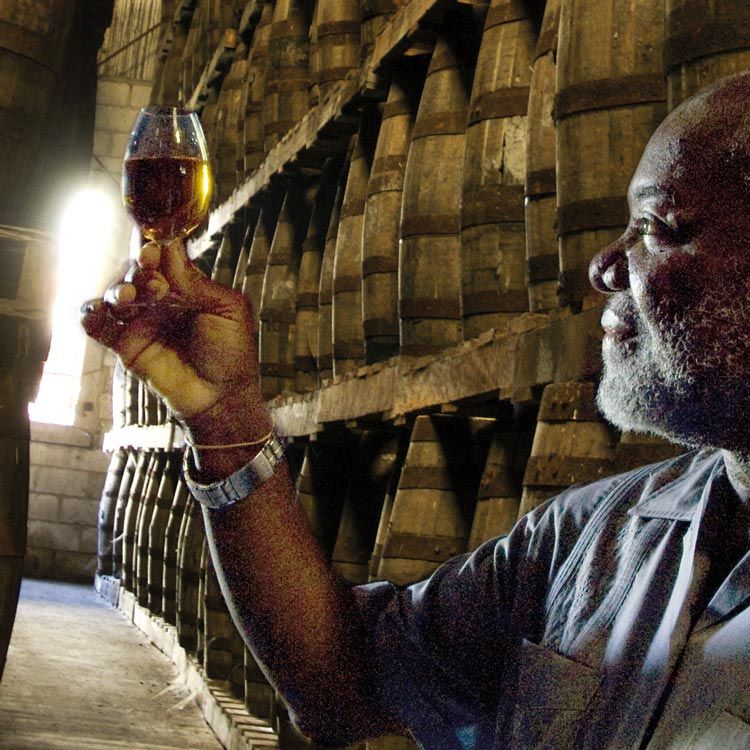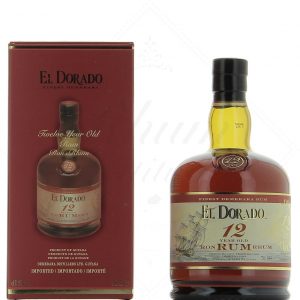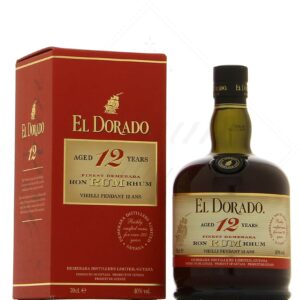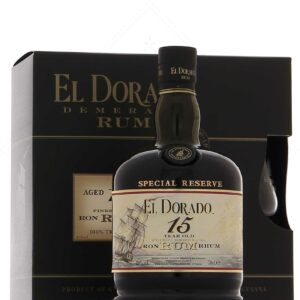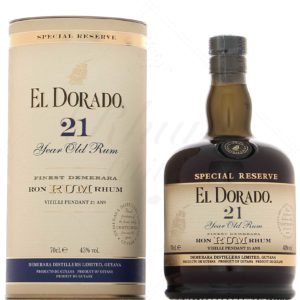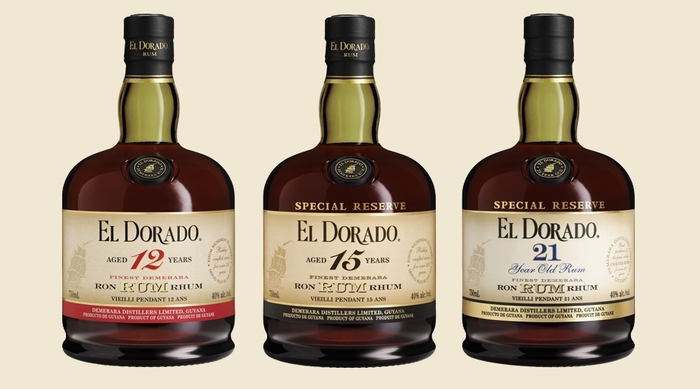
For over two years now, the El Dorado brand has been revising the recipe for its three flagship blends, the 12, 15 and 21 years old. This change was made discreetly, during a small makeover, and the famous Demerara distillers have not communicated on the subject at all. This change in formula could have gone completely unnoticed, if a certain number of enthusiasts had not been taken aback by a fairly significant overhaul of the aromatic profile of the rums, and especially their texture.
Indeed, in the opinion of most experienced enthusiasts , the classic rums of the El Dorado range were very good rums, typical of the prestigious tradition of Guyana, but their watering down tended to tire in the long run and spoil the experience . While many of us discovered the " British tradition " through these rums, they unfortunately remained at the stage of rums intended for initiation.
This is something I have always regretted personally, thinking that Demerara had so much to offer thanks to its living collection of legendary stills, and especially since its production capacity and its well-stocked cellars allowed it to produce high-quality blends in large quantities, like Appleton for example. Well, it turns out that my wishes were heard, or at least that El Dorado has taken into account the trend that the new maturity of amateurs produces a demand for drier and more powerful rums (in reality the real reason is quite different, but you will know that at the end of the article ;).
The tradition of coloring
This evolution took time, because the sweetening of rums seems to be a traditional practice in Guyana , as reported by Marco Freyer of the excellent blog Barrel Aged Mind . He cites an old manual from the 19th century, intended for planters in British Guiana, which describes the primordial aspect of the coloring, as well as its recipe. It essentially involves decanting in a barrel a caramel diluted with distillation heads, this preparation then being intended to age with the rums (we are talking about 1.5 liters of preparation for 350 liters of rum). This practice is not without recalling that of the dosage in the world of cognac, where alcoholic sugars are also aged in barrels.
This coloring practice is different from the more modern one, which uses E150a, an ultra-concentrated and non-sweetening caramel. It therefore results in a significant sweetening, which was quite remarkable until now, but which has largely diminished, in the opinion of the tasters.
Old and new generation: the match
W e therefore took the opportunity to taste the entire range again, to compare it with the old bottlings while supporting our conclusions with obscuration measurements (difference between the alcohol content indicated on the label and that measured by a densimeter. This difference , once interpreted, can indicate the presence of an element other than water or alcohol, a caramel for example, which would "false " the measurement). Thanks to Cyril Weglarz from the Durhum.com website for his help.
It is important to note that an interpretation giving a result between 0 and 5 grams per liter is considered normal, without external addition, because the extraction of compounds from the barrel during aging gives rise to natural obscuration.
El Dorado 12 years old – old version – 40%
Rums blended for this vintage:
++ Double Coffey Columns from Diamond Distillery (SVW)
Enmore Distillery (EHP) Double Wooden Coffey Column
The nose is expressive and slightly full-bodied, with a well-toasted woodiness with nuances of roasting and nuts enhanced by a whiff of sweet spices. It is a fairly clear profile however, pleasant and readable, where we distinguish a certain oxidized complexity of nuts and ripe fruits.
The aeration gives us a softer atmosphere, while we sink a little deeper into the tender fibers of the oak. We then abandon ourselves to vanilla, coconut, while the fruits take a more acidic turn.
The palate is very soft, due to a fairly low alcohol content and especially a very smooth, round and caramelized texture. The nuts are soft, medium intense, they are taken in a vanilla syrup and relaxed by a woody liquid.
In the finish , it is this slightly woody sensation which remains, with a light powder of nuts accompanied by a blond caramel.
“A very soft and mellow expression, extremely easy and ultimately rather light…”
El Dorado 12 years old – new version – 40%
Rums blended for this vintage:
++ Double Coffey Columns from Diamond Distillery (SVW)
Enmore Distillery (EHP) Double Wooden Coffey Column
The nose is relatively light, with ethereal, finely fruity notes. Held together by a dry, toasty woodiness, this rum's taut profile only begins to deliver its luscious nutty aromas after a few moments' rest.
With aeration, the sweetness of pecans and maple syrup take over, much to our delight. The woodiness is coated with a caramelized, lightly roasted mixture, for an American oak profile that's both gourmand and full of character.
The palate is very smooth and fluid, with a very easy attack that erases any possible aggression from the alcohol. Nuts and spices then enter the scene, conveyed by a gently alcoholic liquid woodiness and sprinkled with notes of tangy fruit.
The finish is light and gently spicy, with a veil of vanilla masking a handful of exotic fruits and pits, concentrated but distant.
"A rum quite typical of his tradition, which he presents here in a very accessible and fluid way..."
On the nose, the new version is lighter and drier at first, while the old one was more amply roasted. With a little air, both versions gain in roundness and gourmandise. But in this the new version seems much more elegant, less sweet and easy.
On the palate, both rums are very smooth, but the old version is distinguished by a rather strong liqueur side. The new version is more fluid and more subtle, but remains very light.
The finish is similar on both rums, except for a sweet sensation that remains on the old version. On the other hand, we notice a sensation of more concentrated rum on the new one.
Here are the measurements we took for these two rums:
Ancient
VAT indicated: 40%
Measured TAV: 34.9%
Estimated amount of caramel = between 19 and 22 g/L
New
VAT indicated: 40%
Measured TAV: 38.2%
Estimated amount of caramel = between 4 and 8 g/L
El Dorado 15 years old – old version – 43% (there was also a 40% version in the past)
Rhums assembled for this vintage:
++ Double Coffey columns from the Diamond Distillery (SVW)
++ Double twisted wooden pot still from the Port Mourant distillery (PM)
Double wooden Coffey column from Enmore Distillery (EHP)
Wooden pot still from the Versailles distillery (VSG)
The well-roasted nose lets us imagine a rum that has largely absorbed the aromas of its toasted barrel. It quickly insinuates itself into the fibers of the wood. It extracts more gently spicy, vanilla, round and gourmet notes like coconut milk.
With aeration, some almost ashy vegetal nuances briefly pass over the glass. They then mingle with other tannic accents, slightly resinous and fresh. We then return to the toasted oak, on which a slightly overcooked, caramelized and concentrated fruit jam agglomerates.
The palate is balanced from the start, with a concentrated, woody and spicy character on the one hand, and a roundness that cannot be ignored on the other. The power of the rum is largely coated by an almost liqueur-like side, where the vanilla comes to beat the toasted woodiness hands down. From this toasted oak, we retain much more of the sweet spices than the tannins or the roasted character.
In the finish , the fruit jam also fades away. We keep in mind a resolutely round character, gently spicy and sweet.
“A woody rum that is as toasted as it is round, as roasted as it is sweet…”
El Dorado 15 years old – new version – 43%
Rhums assembled for this vintage:
++ Double Coffey columns from the Diamond Distillery (SVW)
++ Double twisted wooden pot still from the Port Mourant distillery (PM)
Double wooden Coffey column from Enmore Distillery (EHP)
Wooden pot still from the Versailles distillery (VSG)
The nose is largely roasted, so much so that you can almost guess the powdery side of coffee grounds. The rum's core is relatively light, as evidenced by the fruit candy notes that begin to pass between the toasted oak fibers.
With aeration, the profile remains relatively taut, with ethereal flights that seem to clean the surface of the barrel. They carry with them notes of varnish, toasted wood and flame-roasted nuts.
On the palate, the first impression is of a rather fluid attack. It's like a rum with a toasty woodiness and a slightly diluted maple syrup. The mid-palate then takes us to the heart of the Demerara style, albeit with a great deal of restraint. Toasted, caramelized nuts, ripe exotic fruit, sweet spices and a slightly mineral, powdery edge are all present, again with nuances.
The finish is slightly sweet, gently spicy, with the rum fading rather quickly from the palate.
"An expression in which the register of roasting is treated with great fluidity...".
The difference between the two versions is very marked. The old one is very rich and gourmet on the nose, while the new one seems more sober and roasted.
On the palate, the difference is also noticeable, because the old version is a fight between the toasted woodiness and the roundness of the sugar (fight won by the roundness), while the new version is much more delicate and complex, although very fluid.
The finish is definitely carried away by the roundness on the old version, while the new one is very light.
Here are the measurements we took for these two rums:
Ancient
VAT indicated: 43 %
Measured VAT: 3 6.5 %
Estimated amount of caramel = between 24 and 2.8 g /L
New
VAT indicated: 4.3 %
Measured TAV: 41.6 %
Estimated amount of caramel = between 4 and 8 g/L
El Dorado 21 – old version – 43%
Rhums assembled for this vintage:
+ + Savalle columns of the Uitvlugt distillery (AN – Formerly Albion)
Double wooden Coffey column from Enmore Distillery (EHP)
Wooden pot still from the Versailles distillery (VSG)
On the nose , we immediately feel the great age of this rum. The woodiness is concentrated, but totally harmonious, integrated. The tannins have had plenty of time to blend and harmonize, while retaining a memory of their freshness. A small resinous touch thus joins a handful of very ripe exotic fruits. This forms a full-bodied touch typical of the tradition of this region.
The aeration offers us a well-rested, mellow profile, still very dark. We touch on the domain of sherry, port, sometimes Armagnac, with notes of prune, walnut, stone, almond, date. Then a resinous touch and a well-concentrated fruit paste keep the rum very much alive.
On the palate , the concentrated fruits, tannins and the mineral side of gunpowder immediately tickle our taste buds. The concentration is there, however it is with a certain fluidity that it slides over the palate. The texture is indeed light, and endowed with a slight sweetness. This strangely recalls cooked cane juice and soon coats the whole.
The finish is delicious, marked by pecan nuts and maple syrup supported by a fruit paste with copper accents.
“A character of very old, well-concentrated rum, made accessible by a very fluid texture…”
El Dorado 21 – new version – 43%
Rhums assembled for this vintage:
+ + Savalle columns of the Uitvlugt distillery (AN – Formerly Albion)
Wooden pot still from the Versailles distillery (VSG).
Note that the distillate from the Enmore column is no longer part of the blend.
The nose offers a lovely concentration of toasted wood, abounding in a very typical powdery character that reminds us of the Navy's heyday. The heart of the rum is ample and generous. It's bursting with concentrated, candied exotic fruits, housed in walnut shells like little aroma bombs.
Aeration reveals a complex, harmonious rum. It rests on a concentrated, elegant woodiness, inhabited by dried and candied fruits with intense pits, as well as by a blend of spices with deep aromas. Its full-bodied, powdery character is always present. It gradually asserts itself with the help of a handful of very ripe exotic fruits, reduced and concentrated into a solid core.
On the palate, the full spectrum of Demerara style is on display from the outset. The toasty, licorice-accented woodiness seizes the palate and coats it with caramel, encrusted with pecan and vanilla. Then its roasted side reveals a few charred nuances, bordering on black coffee. The fruit takes over again, in the form of a jam reduced to the extreme. A good handful of cloves have also been thrown into the copper pan.
The finish is rather round and sweet in the long term, with a licorice and cane sugar syrup that sticks to the lips. The memory of a coppery caramel with hints of pits remains.
"A beautiful concentration that sticks to the palate while being very accessible through its round and fluid side..."
The two versions are quite similar on the nose, with their concentration, their candied side and their palpable age. The new version is a little more elegant, with a less "regressive" gourmandise.
The palate is also quite similar, a little mineral, rich. The old version was probably a little less ample on the palate. It was more fluid, while the new one is more strongly toasted.
The finish is in line with the mouth for both versions. The new one seems however a little sweeter in the length.
Here are the measurements we took for these two rums:
Ancient
VAT indicated: 43 %
Measured VAT: 39 %
Estimated amount of caramel = between 16 g/L
New
VAT indicated: 4.3 %
Measured TAV: 39.7 %
Estimated amount of caramel = between 12 and 16 g/L
A gradual evolution
The older versions were measured on bottlings from around 2019/2020 . Johnny Drejer and Wes Burgin had made other measurements around 2015, and had found even higher degrees of obscuration . It therefore seems that El Dorado has gradually reduced the quantities of coloring / sweetener. Let us also remember that with such a number of years of aging (the age accounts of El Dorado are authentic, which allows us to see the excellent age / price ratio of these vintages), it takes a certain amount of time before the changes are really felt .
In an interview with CocktailWonk , Shaun Caleb, the master distiller at Demerara Distillers Limited, says he began exploring a change in aging techniques as early as 2004, primarily for economic reasons. The distillery had traditionally used very old, used casks. They compensated for their low expression with their famous “homemade” caramel. When they significantly expanded their cellars that same year, they realized they would need to produce and store a huge number of full caramel casks. Since this loss of space was a waste of money, they decided to invest in fresher casks instead. The youth of these casks, combined with a strong toast, would provide the same color and a texture close to the old one.
A whole fleet of barrels to replace
These are the barrels that have gradually entered the El Dorado blends. This explains the gradual evolution of the profile, and the fact that the 21 has not yet changed much. The change in policy having in fact taken place in 2004, the 21 barrels are not yet concerned. The differences are thus especially marked for the 12 and 15 year old versions, where the caramel has almost disappeared. It is then the roasting and the woodiness that take over, while the excess roundness fades away.
In any case, it is an opportunity to rediscover a legendary distillery and style. We would even dare to imagine it with a few more degrees, so that it is truly perfect! 😉
Images (c) Demerara Distillers Limited
